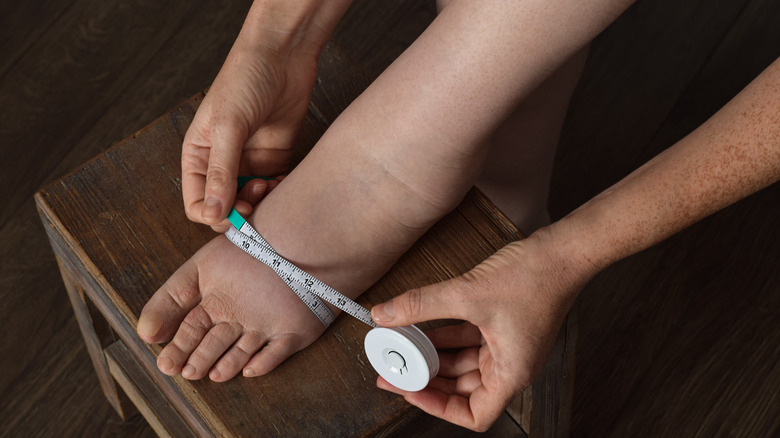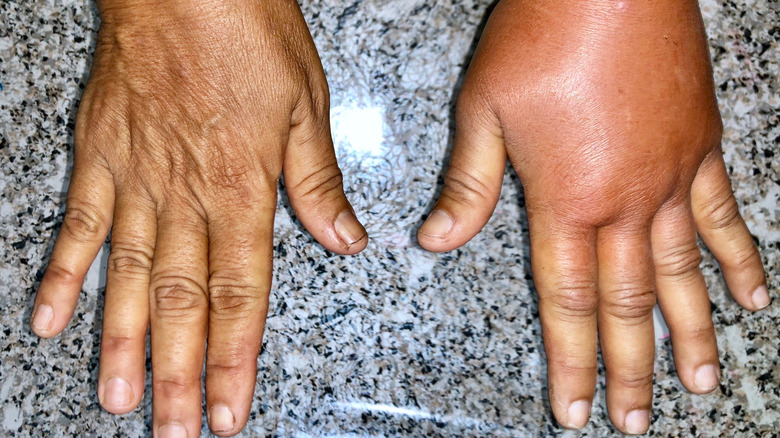What Are The Most Common Causes Of Lymphedema?
According to a 2015 study published in the journal Plastic and Reconstructive Surgery, an estimated 5 million Americans have developed lymphedema. The swelling happens when lymph fluids build up in the soft tissues, often around the arms or legs (via Medline Plus). Lymphedema symptoms can range from severe to mild and include dry or tight skin, headaches, and a heavy feeling in the limb area (via WebMD). Other lymphedema symptoms include fibrosis, persistent inflammation, and fatty deposition, according to the 2015 study.
Mayo Clinic also notes that severe symptoms include limited limb movement, increasing the risk of skin infections like sepsis. According to the Centers for Disease Control and Prevention (CDC), sepsis can cause tissue damage and organ failures and is responsible for 350,000 deaths yearly. If you've been diagnosed with lymphedema or you know someone who has, knowing the most common causes and treatment options will help you understand how to best manage or prevent the condition.
What are the most common causes of lymphedema?
Lymph nodes play a crucial role in the immune system, helping to remove toxins and water products from the body (via Medical News Today). However, certain conditions can cause the lymph nodes to malfunction. According to Cancer Research UK, lymphedema can develop due to cancer treatments — or from the cancer itself. Some people get lymphedema when cancer blocks a lymph node. Other people develop the condition as a side effect of cancer treatments that remove the lymph nodes.
According to Cleveland Clinic, lymphedema associated with cancer treatments and other external causes is commonly classified as secondary lymphedema. The American Society of Clinical Oncology adds that secondary lymphedema is a common side effect of breast cancer treatments, and nearly 83% of breast cancer patients develop the condition. Some breast cancer patients may even develop the condition years after successful treatment, per Johns Hopkins Medicine. Radiation therapy is another cancer treatment linked to lymphedema. The National Cancer Institute notes that lymphedema symptoms linked to radiation therapy might appear during treatment or years after treatment.
Despite the various causes, lymphedema can be hereditary. According to a 2021 study published in the journal Nature Reviews Disease Primers, hereditary lymphedema is categorized under primary lymphedema. Primary lymphedema can be further grouped into three types (Type I, II, and III) based on age, per the National Organization of Rare Diseases (NORD).
Lymphedema diagnoses and treatment
According to the NHS, diagnosis of lymphedema might include taking an MRI, ultrasound, or CT scan to produce clear images of the body's inside. As for secondary lymphedema, a 2017 study published in the Journal of American Physical Therapy Association notes that the condition can be diagnosed through clinical history, physical examination of tissue quality, symptomatology, and limb volume measurement.
Regarding treatment, the American Cancer Society (ACS) notes that there's no specific way to prevent lymphedema caused by cancer. This is especially true for people who are high risk. However, ACS recommends frequent medical checkups, maintaining a healthy weight, and becoming extra vigilant of blood draws or injections. Lymphedema is characterized by a block of lymphatic fluids; therefore, walking, swimming, yoga, tai chi, and other activities can drain the lymphatic fluids and help manage symptoms, according to Cancer Research.
Apart from these at-home remedies and coping mechanisms, several medications, lymphedema therapy, and surgical interventions are also available. According to Mayo Clinic, doctors can prescribe medications for specific lymphedema symptoms, like antibiotics for cellulitis. Surgical lymphedema treatments can include lymph node transplant, new drainage paths which work best for early-stage lymphedema, and surgical removal of fibrous tissues if the condition becomes severe.



